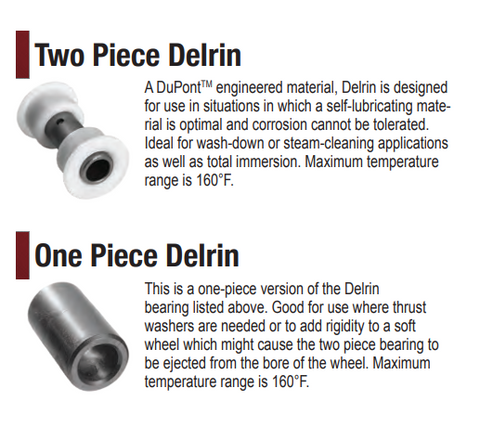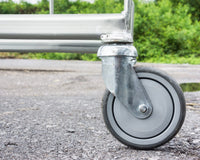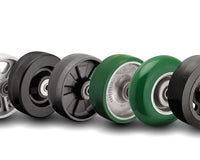Keeping your casters greased and in their optimal operational condition is paramount to getting the most out of your mobility investment. In this blog post, you'll find the best method available for greasing industrial roller bearing casters in order to get the best performance possible in ergonomics and material handling. This blog post is based off our YouTube video found here.
Step 1: Gather Your Materials
The first step in greasing your casters is to gather the necessary materials. You'll need a caster greasing kit, which typically includes grease, a grease gun, and a nozzle attachment. You can find these kits at your local hardware store or online. You'll also want to have a rag handy for any cleanup along the way, and a brush or second rag to remove dirt and other gunk when the time comes.
Step 2: Safety First
Before starting, always remember that safety comes first. Wear gloves and eye protection to keep your hands and eyes protected from any grease splatter or debris. Some grease contains ingredients that have the potential to irritate eyes and skin should the come into contact with the body, so preventing this contact is certainly something that should be done.
Step 3: Identify the Caster Type
Next, it is important that we identify the type of casters you have. Different casters may have specific greasing points, so it's important to know your equipment. If you're unsure, check the manufacturer's guidelines or manual. Typically, there will be two grease zerk locations, one in the swivel section of the caster rig (this will not be present in maintenance-free casters) and the other being in the head of the axle and or the core of the wheel.
Step 4: Determine Caster Wheel Bearing Type
Before going any further, it is important to confirm the type of bearing your caster uses in order to ensure that the right maintenance is performed. There are a few types of commonly used bearings, with the most popular types being either a roller bearing, which requires grease, and the other two popular types are sealed ball

bearings, which do not need additional grease as they come pre-greased and sealed to keep out contaminants, and the other being a self-lubricated Delrin bearing which also does not require grease.
Roller bearings are very popular as they are economical, handle impact, and provide good industrial mobility. They require regular greasing to maintain optimal performance and you will notice them getting loud when they do not have proper grease levels.

|
 |
Step 5: Check Manufacturer Guidelines
To determine the type of bearings your casters have and whether they need greasing, always check the manufacturer's guidelines or the caster's manual. This information will guide you on the specific maintenance requirements for your casters, including the frequency to which you should grease. Typically, a caster with daily usage would need to be greased two to four times per year depending on cart/equipment usage (could be more or less depending on your individual usage). Heat and exposure to moisture can also play a role in casters requiring more frequent lubrication requirements.
Step 6: Clean the Casters
In order to prepare the caster for greasing, any dirt or debris must be cleaned off of the caster. Use a brush or cloth to remove any dirt, debris, or old grease from the caster grease zerk areas, raceways, and wheels. Be sure to double check any pockets on the wheel or the fork where contaminants may have built up over time during use. This ensures that the new grease can do its job effectively and no debris will impact the caster performance.
Step 7: Apply Grease
At this point, it's time to apply the grease to the caster. Begin by attaching the nozzle to the grease gun and carefully inserting it into the greasing points of the caster. Apply a moderate amount of grease, being mindful not to overapply, as too much grease could bind up the caster. Over-greasing can be as bad as under-greasing and cause unwanted friction.
Step 9: Rotate the Caster
In order to ensure that the grease which you just applied is spread throughout the caster, start to rotate the caster at any moving point, ensuring that the grease is evenly distributed. This helps to coat all moving parts, preventing friction and prolonging the life of your casters.
Step 10: Wipe Excess Grease
Now that you've applied the grease and spread it evenly, it's a good idea to wipe away any excess grease with a clean cloth. This step is crucial, as excess grease can attract more dirt and debris, leading to a messy and less efficient setup.
Remember, understanding the type of bearings your casters has along with its estimated usage frequency is crucial in determining the appropriate maintenance routine. Always refer to the manufacturer's guidelines to ensure you're giving your casters the care they need. Additionally, be on the look out for more How To walkthroughs, both here on the blog and by subscribing to our YouTube channel for video versions.



